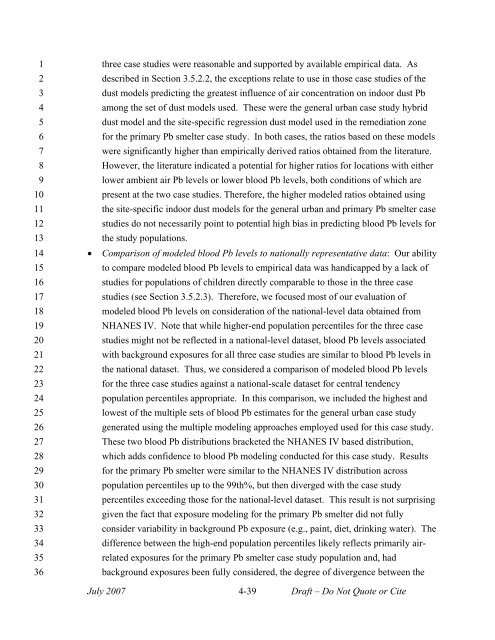Lead Human Exposure and Health Risk Assessments for Selected ...
Lead Human Exposure and Health Risk Assessments for Selected ...
Lead Human Exposure and Health Risk Assessments for Selected ...
Create successful ePaper yourself
Turn your PDF publications into a flip-book with our unique Google optimized e-Paper software.
1<br />
2<br />
3<br />
4<br />
5<br />
6<br />
7<br />
8<br />
9<br />
10<br />
11<br />
12<br />
13<br />
14<br />
15<br />
16<br />
17<br />
18<br />
19<br />
20<br />
21<br />
22<br />
23<br />
24<br />
25<br />
26<br />
27<br />
28<br />
29<br />
30<br />
31<br />
32<br />
33<br />
34<br />
35<br />
36<br />
three case studies were reasonable <strong>and</strong> supported by available empirical data. As<br />
described in Section 3.5.2.2, the exceptions relate to use in those case studies of the<br />
dust models predicting the greatest influence of air concentration on indoor dust Pb<br />
among the set of dust models used. These were the general urban case study hybrid<br />
dust model <strong>and</strong> the site-specific regression dust model used in the remediation zone<br />
<strong>for</strong> the primary Pb smelter case study. In both cases, the ratios based on these models<br />
were significantly higher than empirically derived ratios obtained from the literature.<br />
However, the literature indicated a potential <strong>for</strong> higher ratios <strong>for</strong> locations with either<br />
lower ambient air Pb levels or lower blood Pb levels, both conditions of which are<br />
present at the two case studies. There<strong>for</strong>e, the higher modeled ratios obtained using<br />
the site-specific indoor dust models <strong>for</strong> the general urban <strong>and</strong> primary Pb smelter case<br />
studies do not necessarily point to potential high bias in predicting blood Pb levels <strong>for</strong><br />
the study populations.<br />
• Comparison of modeled blood Pb levels to nationally representative data: Our ability<br />
to compare modeled blood Pb levels to empirical data was h<strong>and</strong>icapped by a lack of<br />
studies <strong>for</strong> populations of children directly comparable to those in the three case<br />
studies (see Section 3.5.2.3). There<strong>for</strong>e, we focused most of our evaluation of<br />
modeled blood Pb levels on consideration of the national-level data obtained from<br />
NHANES IV. Note that while higher-end population percentiles <strong>for</strong> the three case<br />
studies might not be reflected in a national-level dataset, blood Pb levels associated<br />
with background exposures <strong>for</strong> all three case studies are similar to blood Pb levels in<br />
the national dataset. Thus, we considered a comparison of modeled blood Pb levels<br />
<strong>for</strong> the three case studies against a national-scale dataset <strong>for</strong> central tendency<br />
population percentiles appropriate. In this comparison, we included the highest <strong>and</strong><br />
lowest of the multiple sets of blood Pb estimates <strong>for</strong> the general urban case study<br />
generated using the multiple modeling approaches employed used <strong>for</strong> this case study.<br />
These two blood Pb distributions bracketed the NHANES IV based distribution,<br />
which adds confidence to blood Pb modeling conducted <strong>for</strong> this case study. Results<br />
<strong>for</strong> the primary Pb smelter were similar to the NHANES IV distribution across<br />
population percentiles up to the 99th%, but then diverged with the case study<br />
percentiles exceeding those <strong>for</strong> the national-level dataset. This result is not surprising<br />
given the fact that exposure modeling <strong>for</strong> the primary Pb smelter did not fully<br />
consider variability in background Pb exposure (e.g., paint, diet, drinking water). The<br />
difference between the high-end population percentiles likely reflects primarily airrelated<br />
exposures <strong>for</strong> the primary Pb smelter case study population <strong>and</strong>, had<br />
background exposures been fully considered, the degree of divergence between the<br />
July 2007 4-39 Draft – Do Not Quote or Cite
















